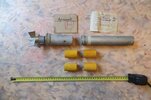Hi everyone,
I am on the hunt for some further information regarding the Soviet BB-1 depth charges.
So far, I have worked out that it is effectively a big barrel filled with 135kg of TNT.
There seems to be a bit of conflicting information that I have found regarding which fuzes are fitted. Some sources say that it would have been HGB or VGB, and others say 1930's to early 50's K3. The K3-M superseded the K3 in approximately 1953 apparently.
I guess my question would be, is there any documentation out there that could point me in a better direction?
Any help would be greatly appreciated.
I am on the hunt for some further information regarding the Soviet BB-1 depth charges.
So far, I have worked out that it is effectively a big barrel filled with 135kg of TNT.
There seems to be a bit of conflicting information that I have found regarding which fuzes are fitted. Some sources say that it would have been HGB or VGB, and others say 1930's to early 50's K3. The K3-M superseded the K3 in approximately 1953 apparently.
I guess my question would be, is there any documentation out there that could point me in a better direction?
Any help would be greatly appreciated.

